|
|
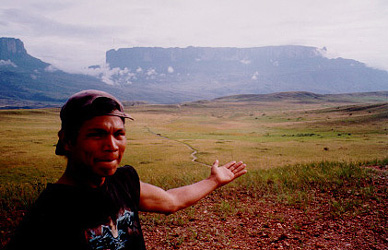
|
|
October 1999- The trip to Roraima was arguably the biggest excursion that I have gone on in Venezuela. By "biggest", I mean that it was the longest and most involved and took the most preparation. Rob, Tom, and I elected to organize the trip ourselves instead of using a tour agency. Although this was risky, I feel that the effort was worth the saved expense. Unfortunately most of the responsibility for planning the trip fell on my shoulders since Tom was busy with work and Rob was out in Merida. I found two excellent web pages about Roraima that were very helpful and also browsed tour agency web sites in order to familiarize us with their itineraries for Roraima. As far as equipment I had everything we needed, the food was the hardest part to sort out. Rob kept ranting about "gourmet cooking" and how he wanted to eat really well on our trip. Since the burden fell on my shoulders and I couldn't exactly just run down to REI for the latest freeze-dried wonders, the menu took some creativity. If you don't know by now, Roraima is a tepui (the Pemon Indian word for plateau) located in southern Venezuela in the Canaima National Park. The plateaus are made up of quartzite and sandstone and tower hundreds to thousands of feet above the valley floor. In addition to the geology, Canaima National Park boasts fantastic vegetation. One third of the plants in the park are not found anywhere else in the world. |
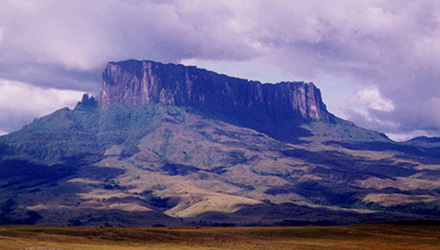 |
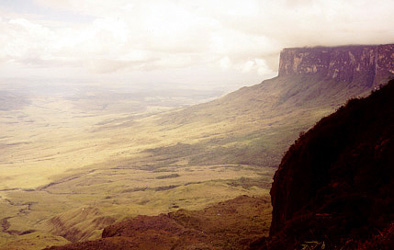 |
|
Rob flew to Puerto Ordaz Friday morning and then Tom and I met up with him there on Saturday. Rob had arrived a day early to get our permit for the trip, for some reason it could only be obtained at the InParques office in Puerto Ordaz, not in Caracas or Roraima. We later found out that we did not need the permit at all and InParques just uses that policy to discourage people from coming without guided tours. Rob met us at the airport and then the three of us took a cab to the sketchy bus station in San Felix where Rob had already arranged our transportation to San Francisco de Yuruaní for that same evening. (Note: If you are planning on travelling by bus from the Puerto Ordaz region use the bus terminal in Cuidad Guyana, not the terminal in San Felix.) We left our packs in the bus office and set off for dinner, eager to hear Rob's stories from his recent stay in Merida. There were no restaurants near the bus terminal, so we ate dinner on the premises. The dingy establishment was no less dubious than its surroundings. After being served a plate of pabellon criollo my appetite was quickly curbed. I ate two bites of rice and gave up. Rob on the other hand wolfed down his entire dinner and promptly got sick for three days. From the diner we went back to get our packs and redistribute the community goods but no one was at the office. We passed the hot and humid evening with stories and people watching. The terminal was a strange mix of armed military, shady salesman, and indigenous people living in a makeshift camp at one end of the station. We finally got our bags moments before the bus arrived, but we didn't exactly feel fortunate. Our bus was not air conditioned like most the others and all the seats were bent and stained. To make matters worse there was salsa music blaring, just like a carrito (small bus) in the city. No big deal right, we only had to spend six hours of the night on this rolling deathtrap (sigh). Just when I thought that the night could not possibly get worse, four drunk National Guardsmen boarded the bus and sat down right in front of us. They were laughing and drinking the entire time. Seats started opening up as people got off though and eventually we got a little sleep. Between the bus ride and Rob's ailing stomach, this trip was not off to a good start. |
 |
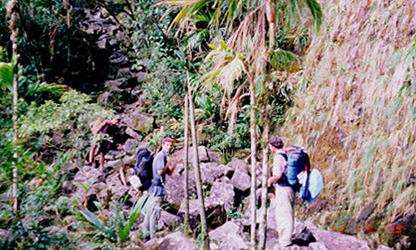 |
|
At sunrise we finally arrived in San Francisco de Yuruaní and departed from the bus. Waiting along side the road was a local Pemon Indian named Gustavo. He invited us to his house, where we hashed out the terms of our trip. We paid him in advance for his services as a guide (US$25 per day) and he arranged for our transportation to Paraitepui and fed us breakfast. By this time Rob really wasn't feeling well, to the point he was talking about staying behind. I drugged his food when he wasn't looking though and after breakfast he felt a little better. We rode in the back of a long wheelbase Land Cruiser to the starting point of Paraitepui along the twisty, narrow road. The vehicle looked like it should have been put out to pasture long ago due to its lack of shocks, healthy use of bailing wire, and large rust holes. At one point during a river crossing water started running through the cab, but this didn't seem to concern the driver. Once to Paraitepui we each had to sign in at the InParques office and account for every wrapper for every piece of food to make sure nothing was left behind. Although this was a pain, it was a necessary evil given the large number of people who come to visit the tepui. The four of us finally set off at noon under the hot midday sun. We didn't get far before two things became painfully obvious: 1) I was out of shape and should have done some training for this trip, and 2) I was carrying way too much stuff. We stopped so I could transfer some items to Tom and Rob before continuing on another four hours to the Rio Kukenan. This was to be our camp for the night, and except for the biting gnats it was a nice location. These gnats were fierce; they actually drew blood when they bit you (I have the scars to prove it). The only other people near the river were a German film student and his guide. Tom was not overly interesting in speaking German so the first night we established our camp routine, which involved Rob preparing the food while Tom and I handled clean-up. We headed to bed after sunset but still well before our normal "city time". Roraima was still far in the distance at this point and we planned to hike to the base the next day. |
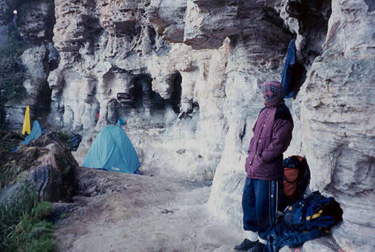 |
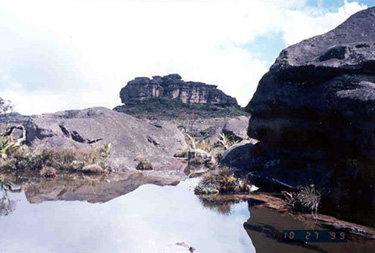 |
|
In the morning I sorted out some non-essential items (read: anything heavy that I hadn't already passed off to Tom or Rob) and Gustavo buried them near camp so we could pick them up on our way back. The terrain on Tuesday day was much the same as the day before, rolling foothills more than actual mountain climbing. With sunny weather and not many other groups around we recognized our luck. It took us most of the day to reach the foot of the tepui, but we kept an easy pace with plenty of stops along the way. At the base of the plateau there was a group of Israelis coming down from the top, in addition to the German from the night before. After setting up camp Rob was going to get water (barefoot) when he almost stepped on a baby rattlesnake. Gustavo found it and killed it while Rob made an effort to be more careful for the rest of the week. Gustavo was a good guy and a great guide. He was tough too. Here I was outfitted with the latest and greatest accessories from REI and Gustavo had a home-woven wicker pack and old shoes with insoles that he had cut out of cardboard with a knife. He never complained or missed a step though. I like to think that he enjoyed our company because we spoke Spanish and shared our food with him. Many of hikers he guides are foreigners who only want direction, not conversation. Gustavo was interesting in learning English too and Rob made an effort to help him whenever possible. |
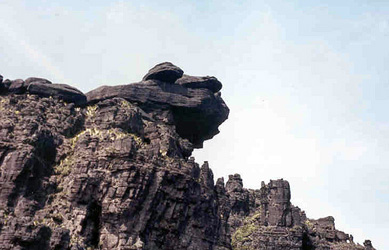 |
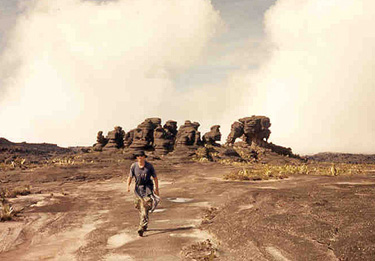 |
|
Tuesday morning we broke camp and finally scaled Roraima. Although the day's hike was not far, much of it was climbing hand and foot over slippery roots and loose boulders. We had shifted from the plains to the rainforest at this point. There was one waterfall that we had to pass under but it was only a trickle. Once again we were fortunate to have clear skies because the waterfall could have proven troublesome otherwise. I felt as though we were climbing straight up into the sky as I peered down on our campsite from the night before. Once on the top we took some pictures and breathed a sign of relief. Now all we needed to do was find shelter. Gustavo took us to one of the "hotels", which was a large rock wall with overhanging formations that would protect you from foul weather. The hotel was a little cramped because there was already a British couple there along with their a guide and two porters, but there was still room for all of us. It struck me as odd to have someone else carry all your gear and cook for you, but it was actually common in Roraima. Of the dozen or so groups that we saw during the week only one other party did not have porters. Call me old-fashioned but if someone can't carry their own gear maybe they should think twice about going. Most of the porters were old Indians who had to carry two packs (their own and that of the tourist) and all they had were rubber boots or slip-on shoes. I think that the porters made more of an impression on me than anything else during the trip. Anyway, back to our neighbors. They were very… British. The guy seemed like an alright bloke but the woman was just horrible. Rob and Tom have covered a good portion of the globe between them but you would never know it upon first talking to them. Since Rob had worked in London for a year he started made conversation with the Brits and it wasn't long before the woman started boasting about all of the places that they had been. The thing was they hadn't seen any more of the world than Tom and Rob. |
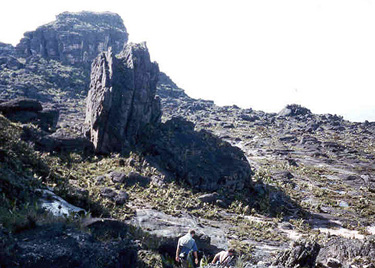 |
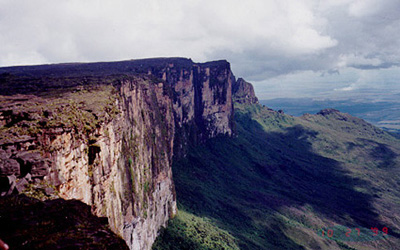 |
|
Wednesday morning the Brits headed out and left the hotel to us. Gustavo began our first day on top of Roraima by leading us on a hike to the Triple Point, where Brazil, Venezuela, and Guyana meet. It was on this walk that we were exposed to the spectacular geology of Roraima. The tepuis look flat from the valley floor but once on top you find that they are covered with rolling, undulating layers of windblown sandstone similar to the geology of southern Utah. Gustavo pointed out different landmarks, such as "Two Frogs Kissing" and "Monkey Eating Ice Cream". The peculiar names represent what the formations resemble. Vegetation and pools of water were abundant on our hike. We did not see much wildlife during the trip; the exception being the yellow-bellied frogs that are unique to Roraima. Once to the Triple Point we took pictures and ate lunch. When returning from the Triple Point we went to El Foso, a large sinkhole full of water. Tom and I took the time to discuss the origin of the hole in the sandstone. Gustavo then guided us down a difficult and dangerous route that led to a cave within the sinkhole. Once inside the cave it was well worth the risk as we could better view the unique formation. From the hole we started our three-hour hike back to the hotel. Half way back we realized that the dark clouds behind us were moving faster than we were. The four of us quickened our pace but ended up in a huge downpour an hour before reaching the hotel. We were all reasonably prepared, but it made little difference in the outcome. The trails had turned to streams and the rock shelves were now flowing with water. Just when I was starting to feel sorry for myself a group of 15 British tourists came into view. They were accompanied by their 15 porters and had just arrived on top of the tepui. The thirty of them were searching for a vacant hotel to shelter themselves from the storm. Our situation suddenly did not seem so bad. Once back to the hotel we changed into dry clothes and warmed up with some hot chocolate. We made an effort to dry out our clothes and boots under the outcrop, but the humid air and lack of sunshine conspired against us. During dinner Rob commented on how clever Gustavo's menu was. Our guide had brought two kilos each of oats, pasta, and rice. That along with some sauces was all of his food. I almost threw a fit after the trouble I had gone through to find the food that we brought. Tom restrained me until I calmed down and before I knew it the sun had set and it was time to go to bed again. |
 |
 |
|
Thursday was our free day. Typically people only spend two nights on the top of the tepui before heading back down but we planned to spend as much time as possible on the top of Roraima. This allowed us to go to places that most people do not get to see and I really enjoyed being able to relax in this beautiful environment. Gustavo took us to a group of small pools of quartz crystals. Unfortunately the crystals did not turn out well on film but they were impressive in person. We continued on from the pools to the southern edge of Roraima, facing towards the Kukenan tepui. It was almost surreal to look down and witness a sea of clouds below you moving between the two giant land masses. The face of the cliff was sheer on this side to the valley thousands of feet below. After gazing out in silence we returned to the hotel and ate our lunch there. Having satisfied our appetites we swung across to the northern edge of the tepui and looked out from its highest point. From there it seemed as if you could look down on the whole world. We spent hours gazing out at the world below and hardly spoke to one another; it was one of the most amazing views I have ever seen. Friday morning we had to head back to civilization. We hiked to the Rio Tek, near where we had stayed the first night of our adventure. It was a long hike but we got started early and as they say, it was all downhill from here. Our early start ensured that we stayed in front of the group of thirty, whom were also headed back to civilization. There was a lot of traffic coming up the mountain as we descended, once again indicating our good fortune. The day went by fast and our feet moved swiftly. We were in the zone by this point and felt no pain. Proceeding to the foothills meant we would be camping by the river and could take a much needed bath, but it also signaled the return of the biting gnats. The British party camped next to us and provided the humor for the evening. The phrase "This be-ah is wahm" (said is snooty British voice) is still a favorite of ours to this day. We found that the Brits had quite a different experience than the three of us. They were part of an all-inclusive tour that provided food, equipment, guides, and transportation. They also paid $2200, as opposed to the $250 Rob, Tom, and I each coughed up to cover food and Gustavo's services. |
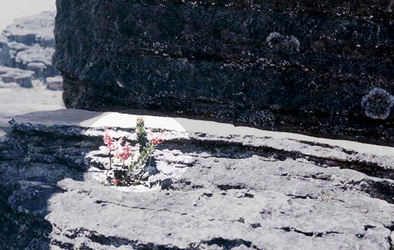 |
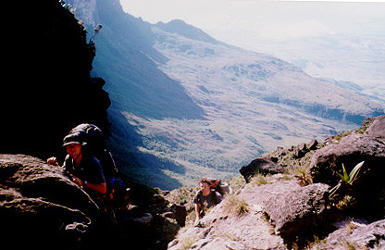 |
|
Saturday morning we hiked the rest of the way to Paraitepui. Rob and Tom were moving swiftly now that we had consumed all the food, but I was left carrying items such as the cooking gear, water filter, and tent. I was hurting at this point and was relieved once we finally arrived in Paratepui. The InParques ranger in Paratepui had his hands full with incoming hikers so he did not inspect our trash. My relief didn't last long when I realized that we would be taking the same Land-Cruiser-of-Death back to Gustavo's house . Once in San Francisco de Yuruaní Gustavo's wife made us boiled chicken and then the three of us headed to Santa Elena de Uairen (once again in the same Land-Cruiser-of-death). Santa Elena is located on the border with Brazil and where Tom and I were to part company with Rob. Rob was heading south into Brazil while Tom and I were returning to Puerto Ordaz by bus. After carefully inspecting the evening's bus we purchased tickets and then ate our "last supper" with Rob. It was a sad parting but we took comfort in knowing that we will see each other again. The bus we took to return to Puerto Ordaz had air conditioning, and it was cold. The inside of the bus was colder than it ever got on top Roraima. I bundled up and managed to sleep much of the night. Once arriving in Puerto Ordaz Tom and I tried to sleep on the benches at the bus terminal but were kicked out by a guard at six in the morning. We stumbled over to the airport and slept there until our noon flight back to Caracas. The transition from adventure to work was not a pleasant one but I made it without too many objections. As for Rob, he renewed his visa for Venezuela and went to chase his beloved in Merida instead of staying in Brazil. |
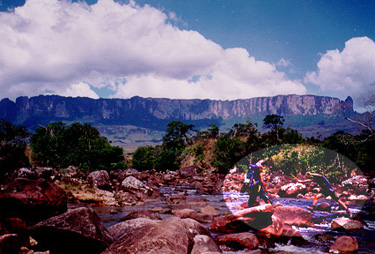
|
|
|